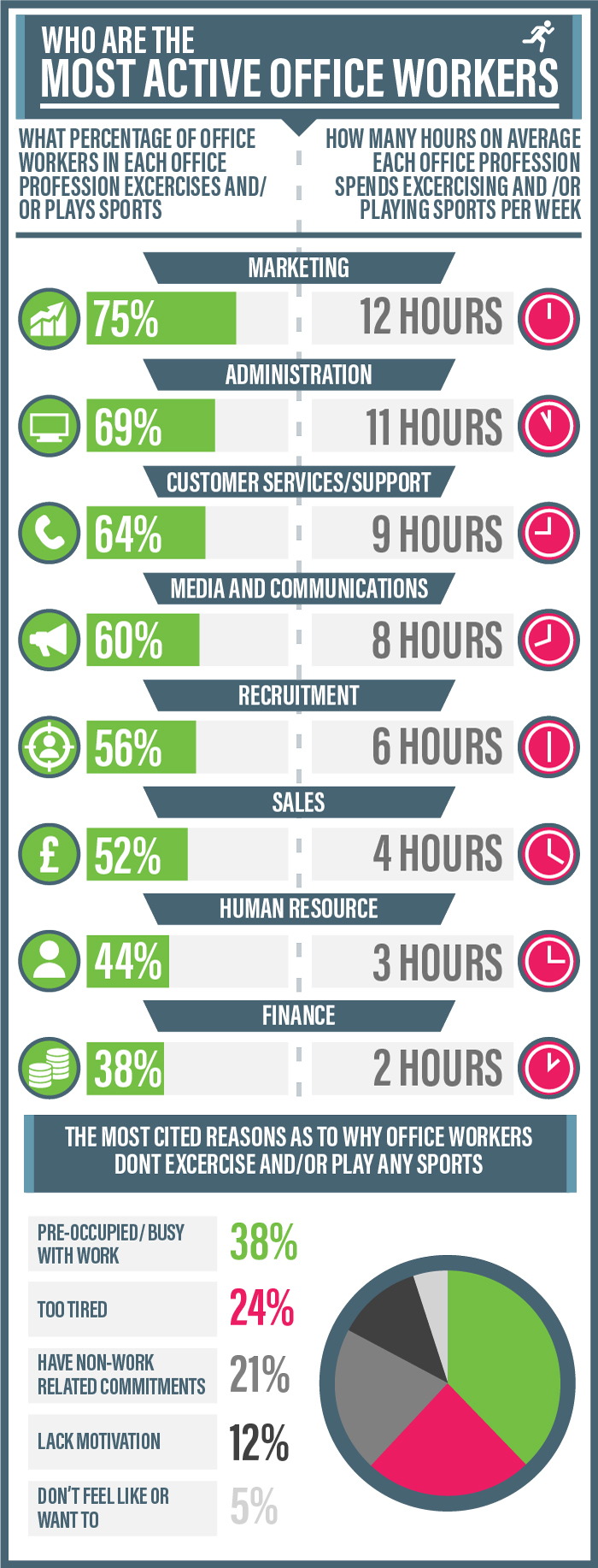With office workers under immense pressure to consistently deliver results and cope with increasing workloads, many often end up making their desks their sanctuary. In fact, research has shown that 37 per cent of men and 45 per cent of women spend less than 30 minutes of their day up on their feet at work. This is indeed worrying, as a sedentary lifestyle increases the risk of obesity as well as the prevalence of life changing diseases.
Savoystewart.co.uk surveyed 720 people in eight different professions to find out who the most active office workers are in the UK. They were presented with a series of questions about whether they did any exercise or play sports and if so, how many hours per week.
The results from the survey found that those in marketing are the most active office workers, with 75 per cent exercising or playing sports for an average of 12 hours per week. Those in administration positions came second, but those in finance were the least active office workers, with only 38 per cent exercising or playing sports for a mere average of 2 hours per week.
In general, for those workers who stated they did not exercise or play any sports, the majority (38 per cent) attributed it to being too ‘busy with work’ to do so.
Business development coach, Barry Desmond, says this is symptomatic of the break-neck pace of businesses today. “Businesses now more than ever are working at a rapid pace in the backdrop of an uncertain economic climate thus expect their employees to continually give their all. Whilst it’s understandable from their point of view, they must not over burden employees with drastic workloads and expectations,” he says. “When companies do this, they are not only overstretching their work force but taking away valuable time they have outside of work. This includes time they could be spending to improve or enhance their fitness levels after being sedentary throughout the normal working day”.
SavoyStewart.co.uk MD Darren Best believes that the responsibility to promote a healthy lifestyle in the office partly falls on employers. “With the associated risks of being sedentary for long periods of time well documented, it’s imperative that office workers make every effort to be active as possible,” he says. “With various avenues to improve fitness whilst at as well as outside of work, employees should aim to integrate some form of physical activity into their daily route. Employers also have a role to play, as they can harvest a culture whereby employee wellbeing is at the forefront of their ethos. This includes subtle things such as not overloading employees with work so they have the time to purse activates that will allow to improve as well as maintain their fitness levels”.
Given the high-levels of stress among UK employees, organisations are introducing wellbeing initiatives to support the physical and mental health of employees at work, according to separate research from Robert Half UK. Nearly half of businesses offer tools designed to promote wellbeing in the workplace, with one in seven providing stress management seminars or training and annual leave for personal and mental wellbeing. Other initiatives being introduced include counselling, leaving work early on a Friday, and limiting the amount of overtime that employees can do.
“Starting a wellbeing programme may come at a cost but health and happiness go hand-in-hand,” explains Phil Sheridan, senior managing director at Robert Half UK. “Creating a working environment that encourages good health fosters a more stable workforce. It also helps facilitate better team relationships, which in turn drives employee satisfaction, performance and morale.”
At a time when organisations are experiencing a shortage of skilled workers, UK businesses are also looking to create agile work environments that provide a better work experience and improve staff loyalty. Alongside introducing flexible working policies, organisations are rethinking how the design of the workplace impacts health, wellbeing and productivity. One in seven employers have developed ergonomic workplaces and supply healthy food or drinks.
To promote healthy behaviours, UK employers are also turning to new measures that encourage physical wellbeing. One in five have introduced company cycling schemes, followed by subsidised gym membership, corporate sporting and fitness, and tools, such as Fitbits or step counters, that encourage employees to move.
“It’s important to remember that employees are an organisation’s most important asset,” concludes Sheridan. “Those companies that promote and protect workers’ health are building a culture dedicated to the overall wellbeing and happiness of employees. These businesses are likely to see higher levels of staff engagement and productivity, helping them become more successful and competitive in the long-term.”
This infographic from SavoyStewart.co.uk dissects the job roles with the most and least active workers.







